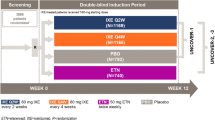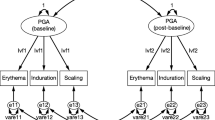Abstract
Background
The product of Physician Global Assessment (PGA) and Body Surface Area (BSA) (PGA × BSA) has been proposed as a simple and sensitive instrument for measuring psoriasis severity.
Objectives
To assess the simple measure, PGA × BSA, with respect to criterion validity, reproducibility, responsiveness, and interpretability among Chinese patients with psoriasis.
Materials & Methods
Assessments of psoriasis severity were performed by two dermatologists independently for the baseline survey and by one dermatologist during follow-up. Criterion validity and reproducibility were assessed using Spearman correlation coefficients (r). Responsiveness was assessed by comparing the percentage changes in PGA × BSA (PGA × ΔBSA [%]) between patients grouped by disease improvement. The receiver operating characteristic (ROC) curve was used to determine the threshold of PGA × ΔBSA for disease improvement, anchored by 50% and 75% reduction in Psoriasis Area Severity Index (PASI).
Results
A total of 276 patients participated in the baseline survey, of whom 93 were followed. PGA × BSA highly correlated with PASI (r = 0.94), Simplified PASI (SPASI, r = 0.93), and Psoriasis Log-based Area and Severity Index (PLASI, r = 0.90) measured at baseline, indicating good criterion validity. The between-evaluator consistency of PGA × BSA was r = 0.95, indicating high reproducibility. PGA × ΔBSA highly correlated with both ΔPASI (r = 0.86) and ΔPLASI (r = 0.85), suggesting good responsiveness. The threshold of ΔPGA × BSA for disease improvement was 57% and 73%, as indicated by 50% and 75% reduction in PASI, respectively.
Conclusion
PGA × BSA demonstrates good biometric properties and may be used to measure the severity of psoriasis among Chinese patients.
Similar content being viewed by others
References
Walsh JA, McFadden M, Woodcock J, et al. Product of the Physician Global Assessment and body surface area: A simple static measure of psoriasis severity in a longitudinal cohort. J Am Acad Dermatol 2013;69:931–7.
Fredriksson T, Pettersson U. Severe psoriasis — oral therapy with a new retinoid. Dermatologica 1978; 157:238–44.
Ashcroft DM. Clinical measures of disease severity and outcome in psoriasis: a critical appraisal of their quality. Br J Dermatol 1999; 141: 185–91.
van de Kerkhof PCM. The Psoriasis Area and Severity Index and alternative approaches for the assessment of severity: persisting areas of confusion. Br J Dermatol 1997; 137:661–2.
MacReady N. More liberal interpretation of PASI scores urged. Skin Allergy News 2003; 34:44.
Food and Drug Administration. Dermatologic and ophthalmic drugs advisory committee meeting (minutes from meeting): 23 May 2002.
Carlin CS, Feldman SR, Krueger JG, Menter A, Krueger GG. A 50% reduction in the Psoriasis Area and Severity Index (PASI 50) is a clinically significant endpoint in the assessment of psoriasis. J Am Acad Dermatol 2004; 50: 859–66.
Harari M, Shani J, Hristakieva E, Stanimirovic A, Seidl W, Burdo A. Clinical evaluation of a more rapid and sensitive Psoriasis Assessment Severity Score (PASS), and its comparison with the classic method of Psoriasis Area and Severity Index (PASI), before and after climatotherapy at the Dead Sea. Int J Dermatol 2000; 39: 913–8.
Jacobson CC, Kimball AB. Rethinking the Psoriasis Area and Severity Index: the impact of area should be increased. Br J Dermatol 2004; 151:381–7.
Louden BA, Pearce DJ, Lang W, Feldman SR. A simplified psoriasis area severity index (SPASI) for rating psoriasis severity in clinic patients. Dermatol Online J 2004; 10: 7.
Henseler T, Schmitt-Rau K. A comparison between BSA, PASI, PLASI and SAPASI as measures of disease severity and improvement by therapy in patients with psoriasis. Int J Dermatol 2008; 47: 1019–23.
Wallace AB. The exposure treatment of burns. Lancet 1951; 3: 501–4.
Spuls PI, Lecluse LL, Poulsen ML, Bos JD, Stern RS, Nijsten T. How good are clinical severity and outcome measures for psoriasis? Quantitative evaluation in a systematic review. J Invest Dermatol 2010; 130:93343.
Robinson A, Kardos M, Kimball AB. Physician global assessment (PGA) and psoriasis area and severity index (PASI): Why do both? A systematic analysis of randomized controlled trials of biologic agents for moderate to severe plaque psoriasis. J Am Acad Dermatol 2012;66:369–75.
Walsh JA, Jones H, Mallbris L, et al. The Physician Global Assessment and Body Surface Area composite tool is a simple alternative to the Psoriasis Area and Severity Index for assessment of psoriasis: post hoc analysis from PRISTINE and PRESTA. Psoriasis (Auckl) 2018;8: 65–74.
Merola JF, Amato DA, See K, et al. Evaluation of sPGA × BSA as an outcome measure and treatment target for clinical practice. J Invest Dermatol 2018; 138: 1955–61.
Gottlieb AB, Merola JF, Chen R, Levi E, Duffin KC. Assessing clinical response and defining minimal disease activity in plaque psoriasis with the Physician Global Assessment and body surface area (PGA × BSA) composite tool: An analysis of apremilast phase 3 ESTEEM data. J Am Acad Dermatol 2017; 77: 1178–80.
Duffin KC, Papp KA, Bagel J, Levi E, Chen R, Gottlieb AB. Evaluation of the Physician Global Assessment and Body Surface Area Composite Tool for assessing psoriasis response to apremilast therapy: results from ESTEEM 1 and ESTEEM 2. J Drugs Dermatol 2017; 16: 174–253.
Ryan C, Menter A. Discordance between physician assessment of psoriasis and patient self-assessment: the importance of itch. Br J Dermatol 2016;175:19–20.
Lindström Egholm C, Krogh NS, Pincus T, et al. Discordance of global assessments by patient and physician is higher in female than in male patients regardless of the physician’s sex: data on patients with rheumatoid arthritis, axial spondyloarthritis, and psoriatic arthritis from the DANBIO registry. J Rheumatol 2015; 42: 1781–5.
Acknowledgements and disclosures
Acknowledgements: this work was supported by the National Key Research and Development Project of China “Precision Medicine Initiative” (20I6YFC0900802) and Management Research Foundation of Xiangya Hospital (20I6GL03) and the National Natural Science Foundation of China (81830096, 8I620I08024, 81974479, 81773329). Conflicts of interest: none. Ethics statement: this work was reviewed and approved by the institutional research ethics boards of Xiangya Hospital, Central South University (Changsha, China). Written informed consents were received from all participants.
Author information
Authors and Affiliations
Corresponding author
Supplementary material
About this article
Cite this article
Cao, D., Shen, M., Chen, X. et al. Validation of a simple measure of psoriasis severity based on a longitudinal study of Chinese patients. Eur J Dermatol 30, 674–679 (2020). https://doi.org/10.1684/ejd.2020.3914
Accepted:
Published:
Issue Date:
DOI: https://doi.org/10.1684/ejd.2020.3914




